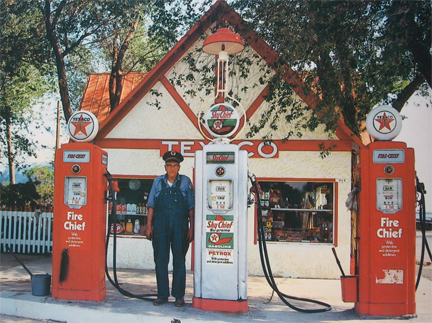
| Monday, May 20, 2013 | Archives | Advertise | Online Buyer's Guide |
Farewell To The Gas Station: The Demise Of A Car-Culture Icon
 One hundred years after the first retail gas station opened (a Gulf station in Pittsburgh), gas stations are slowing receding from the American commercial landscape. Every day, in fact, three or four gas stations close up shop. Some, like the BP in SoHo and the stations on Wisconsin Avenue in Bethesda, are victims of high land values in bustling urban and suburban cores. But other factors are in play throughout the country: rising competition from new gas retailers like Walmart and Costco; the growing efficiency of the American vehicle fleet; and changing driving patterns. Americans are driving less than they did a few years ago, too. When they do drive, they’re more likely to drive cars that get better gas mileage. And with each passing month, a growing cadre of drivers gets around without using gasoline at all. According to the trade publication National Petroleum News, the station count -- which includes public fueling stations, marinas, convenience stores, gas stations, and hypermarkets that sell gas (e.g., Costco) -- was 156,065 at the end of 2012, down 1,328, or about one percent, from 2011. That marked the seventh consecutive year of decline. Since 2002, the station count has fallen by nearly 14,000, or about eight percent. The trend got started in the 1990s, when hypermarkets (grocery store chains and retailers like Costco and Walmart) began to sell gasoline at their big-box locations, said Jeff Lenard, a spokesperson at the National Association of Convenience Stores. Just as Walmart and other giants put pressure on mom-and-pop grocers and retailers, these huge chains, with their ability to run on low margins, put some low-volume gas stations out of business. In more recent years, the economy and technology have been working against gas stations. "The volume of gasoline sales peaked in 2007," Lenard notes. According to the Energy Information Administration, Americans consumed 3.389 billion barrels of gasoline in 2007. But the total has fallen in every year since, down to 3.185 billion barrels in 2012, a decline of six percent. What’s behind the decline? With fewer people working and a decline in goods moving around the country due to the deep recession and weak recovery, vehicles are driving fewer miles than they did before. Broke young Americans aren’t buying cars like they used to. And the persistently high price of gas is pushing more Americans of all ages to use public transportation. According to the Department of Energy, vehicle miles driven peaked in 2008 and were about 2.6 percent below the peak last year. Plus, environmental regulations that require gas-station owners to put in more secure gas tanks have encouraged some owners to get out of the business. And gas stations, like everything else, have become super-sized. Some owners have invested to add pumps to existing stations, the better to compete with larger outfits. And that reduces the need for more free-standing stations. |
 |
NAFA Fleet Management Association 125 Village Blvd., Suite 200 Princeton, NJ 08540 Telephone: 609.720.0882 Fax: 609.452.8004 |







